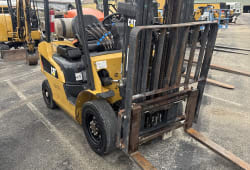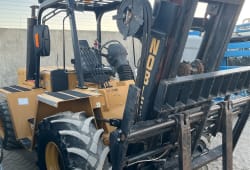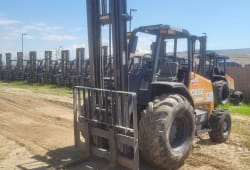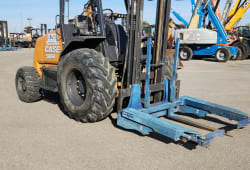Everything About Forklifts: A Comprehensive Exploration
9 Min read
)
December 22, 2023
Forklifts, also known as lift trucks or fork trucks, play a pivotal role in material handling and logistics across various industries. These powerful industrial vehicles are designed to lift, carry, and transport heavy loads with precision and efficiency. This comprehensive exploration delves into the history, types, components, safety considerations, and advancements in forklift technology. Understanding their evolution and capabilities is essential for optimizing operational efficiency and ensuring workplace safety.
History of Forklifts
Early Developments
Early Developments in forklift technology can be traced back to the early 20th century. In 1906, the first known forklift prototype emerged, credited to the pioneering efforts of the Clark Material Handling Company. However, it wasn't until the 1920s that the forklift underwent significant advancements, marking the evolution towards the modern forklift design we recognize today.
World War II Influence
During World War II, the demand for efficient material handling accelerated the development and adoption of forklifts. These machines, pivotal in military logistics, became indispensable for moving heavy loads and streamlining supply chains. The World War II influence catapulted forklifts into widespread civilian use post-war, marking a significant shift in industrial practices and shaping modern logistics and manufacturing processes.
Industrial Revolution Impact
The post-war era saw a surge in industrial activities, further fueling the need for effective material-handling solutions. Forklifts became essential in warehouses, manufacturing plants, and distribution centres, driving innovations and improvements in their design. The Industrial Revolution Impact led to a profound transformation, shaping the way goods were produced, transported, and distributed, marking a pivotal moment in history that accelerated economic growth and technological advancements.
Types of Forklifts
Counterbalance Forklifts
The most common type of forklift, counterbalance forklifts are characterized by their weight distribution, which counterbalances the load being lifted. They come in electric, gas, and diesel variants, suitable for diverse applications. Counterbalance forklifts play a crucial role in warehouses and industrial settings, offering stability and efficiency in material handling tasks, making them indispensable for lifting and transporting goods with precision and ease.
Reach Trucks
Designed for narrow aisle use, reach trucks have an extending mast that allows forklift operators to reach loads at greater heights. These specialized vehicles play a pivotal role in warehouse settings where space optimization is crucial. Reach trucks efficiently navigate confined spaces, contributing to streamlined operations and enhanced vertical storage capabilities.
Rough Terrain Forklifts
Equipped with large, robust tyres and a sturdy frame, rough terrain forklifts are designed for outdoor use on uneven surfaces. Commonly used in construction sites and lumber yards, they offer stability and manoeuvrability in challenging environments. Rough Terrain Forklifts excel in navigating rugged landscapes, effortlessly lifting and transporting heavy loads across gravel, dirt, and other uneven terrains with precision and reliability.
Pallet Jacks (Pallet Trucks)
Pallet jacks, also known as Pallet Trucks, are a more compact type of forklift crafted for efficiently transporting palletized loads at ground level. Whether manual or electric, these essential tools find frequent use in retail and distribution settings, streamlining the movement of goods with precision and convenience.
Telescopic Handler
Forklifts come in various types, each designed for specific tasks. Telescopic Handler, equipped with a telescoping boom, extends its reach and versatility. Widely used in agriculture, construction, and industries needing extended lift capabilities, these forklifts play a crucial role in efficiently handling materials and navigating challenging environments.
Components of Forklifts
Power Source
Forklifts, essential in various industries, come in diverse power sources. They can be electric, utilizing clean energy for indoor efficiency and minimal emissions. Alternatively, propane and diesel forklifts find favour outdoors, offering robust performance. The choice of power source depends on specific operational needs, ensuring versatility across diverse work environments and applications.
Mast
The mast is the vertical assembly that enables the lifting and lowering of loads. It consists of interlocking rails and hydraulic cylinders, providing the necessary height and stability during lifting operations. Mast design plays a crucial role in ensuring safety and efficiency, allowing for precise control of elevation. A well-engineered mast enhances the overall performance and reliability of lifting equipment in various industrial applications.
Forks
Forks, also known as blades or tines, are the components that engage with the load. They come in various lengths and shapes to accommodate different types of loads. Forks can be manually adjusted or hydraulically positioned for versatility. The efficiency of forklifts relies heavily on the design and functionality of these crucial components, ensuring optimal performance in material handling and transportation tasks.
Hydraulics
Hydraulic systems, a fundamental component in industrial machinery like forklifts, play a pivotal role in powering lifting and tilting mechanisms. Essential for controlled movements, these systems utilize hydraulic fluid to transmit force. Whether it's efficiently hoisting heavy loads or ensuring a gentle descent, hydraulics enable the precision needed for optimal performance in diverse lifting and lowering operations.
Controls
Forklifts are essential in material handling and efficiently transporting goods within warehouses and industrial settings. These versatile machines are equipped with controls that enable operators to manoeuvre the vehicle and manipulate the forks. Controls such as a steering wheel, accelerator, brake pedals, and hydraulic levers for lifting and tilting empower operators to navigate tight spaces and handle loads with precision and ease.
Forklift Safety Considerations
Operator Training
Proper training is paramount for forklift operators. Training programs, including Operator Training, cover topics such as vehicle operation, load handling, and safety protocols. Operators must be certified to ensure they can safely and efficiently operate a forklift. This specialized training equips them with the skills and knowledge needed to navigate various work environments, minimizing the risk of accidents and promoting a secure workplace.
Load Capacity Awareness
Each forklift has a specified load capacity, and operators must be aware of these limits. Load Capacity Awareness is crucial to prevent accidents. Overloading a forklift can compromise stability, leading to potential hazards. Load weight, size, and distribution must be carefully considered before lifting to ensure safe and efficient operations within the designated load limits.
Stability Concerns
Forklifts, essential for material handling, demand cautious operation to mitigate Stability Concerns. These vehicles are susceptible to tipping on uneven terrain or when driven too fast. Mastery of the stability triangle, defined by the front wheels and the centre of the rear axle, is imperative for safe forklift operation. Awareness of Stability Concerns ensures a secure working environment and promotes efficient warehouse management.
Maintenance and Inspections
Regular maintenance and inspections are essential to ensure forklifts operate at peak performance. This includes checking brakes, tyres, hydraulic systems, and other critical components. Identifying and addressing issues promptly enhances overall safety. Maintenance and inspections play a crucial role in preventing potential hazards and prolonging the lifespan of the equipment, contributing to a safer and more efficient work environment.
Advancements in Forklift Technology
Automation and Robotics
The integration of automation and robotics in forklifts has transformed material handling. Automated guided vehicles (AGVs) and robotic forklifts are becoming more prevalent, offering increased efficiency and reducing the need for manual intervention. Automation and robotics streamline operations, enhancing productivity, and ensuring smoother, more precise warehouse logistics.
Lithium-Ion Batteries
Recent advancements in battery technology have spurred the widespread adoption of lithium-ion batteries in various applications. One notable example is their integration into electric forklifts, offering extended run times, faster charging, and diminished maintenance requirements compared to conventional lead-acid batteries. Lithium-ion batteries continue to revolutionize diverse industries with their enhanced performance and efficiency.
IoT and Telematics
In the realm of logistics, technological advancements like the Internet of Things (IoT) and telematics have revolutionized forklift operations. These innovations enable real-time data collection and analysis, empowering businesses to implement predictive maintenance, enhance operator performance monitoring, and optimize overall fleet management for unprecedented efficiency and productivity gains.
Ergonomic Design
Modern forklifts are engineered with a keen emphasis on Ergonomic Design, prioritizing operator comfort. Featuring adjustable seats, intuitive controls, and enhanced visibility, these forklifts create a conducive and efficient work environment. The ergonomic advancements not only boost operator well-being but also contribute to heightened productivity in diverse industrial settings.
Future Trends in Forklift Industry
Hydrogen Fuel Cells
As an alternative to traditional power sources, hydrogen fuel cells are gaining traction in the forklift industry. Forklifts powered by hydrogen fuel cells offer longer run times and zero emissions, contributing to environmental sustainability.
Artificial Intelligence Integration
The integration of artificial intelligence (AI) in forklifts enables advanced functionalities, such as predictive maintenance, autonomous navigation, and adaptive load handling. AI-driven forklifts have the potential to further enhance efficiency and safety.
Sustainable Materials
There is a growing emphasis on using sustainable materials in forklift manufacturing. Lightweight and eco-friendly materials contribute to reduced energy consumption and environmental impact.
Conclusion
Forklifts have evolved significantly since their inception, becoming indispensable in the world of material handling and logistics. From their humble beginnings in the early 20th century to the advanced, technology-driven models of today, forklifts continue to play a crucial role in improving efficiency and productivity across diverse industries. As the forklift industry continues to innovate, embracing technological advancements and sustainable practices, it is poised to meet the evolving needs of the modern workplace. In conclusion, the continual evolution of forklift technology underscores its pivotal role in shaping the future of efficient and sustainable material handling practices.

Rex Walz is Boom & Bucket's Manager of Supplier Relations, bringing over a decade of experience in B2B sales and heavy equipment solutions. With a background spanning government, construction, industrial, and commercial sectors, he has a proven track record of driving growth and building trusted customer relationships. At Boom & Bucket, Rex is passionate about helping partners succeed while advancing the company's mission to create the most trusted marketplace for heavy equipment.














